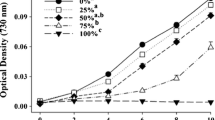Abstract
Cells of the diatomCyclotella meneghiniana were exposed in a closed system to 0.245 ppm 1,3,5-trichlorobenzene. Response of the diatom was measured by quantitative ultrastructure and fatty acid percent composition over a 5-day period. During that time, 28 significant morphological and 13 significant fatty acid percent composition changes occurred. Autophagic-like vacuoles were observed consisten9ly through the sampling periods. In comparison with exposure to 1,2,4-trichlorobenzene, 1,3,5-trichlorobenzene exerts fewer effects in the parameters studied, and these effects were observed most frequently in membranous components during the initial eight hours of exposure. It is suggested that the amount of cellular lipid and the relative reactivity of the isomer are responsible for the observed effects.
Similar content being viewed by others
References
Anderson OR (1975) The ultrastructure and cytochemistry of resting cell formation inAmphora coffaeformis (Bacillariophyceae) J Phycol 11:272–281
Bisalputra T, Antia NJ (1980) Cytological mechanism underlying darkness survival of the unicellular red algaPorphyridium cruentum. Bot Mar 23:719–730
Conner AJ (1980) The differential sensitivity of phytoplankton to polychlorinated biphenyls when cultured heterotrophically or photoautotrophically. Environ Exp Bot 21:241–247
Conner AJ, Mahanty HK (1979) Growth responses of unicellular algae to polychlorinated biphenyls: New evidence for photosynthetic inhibition. Mauri Ora 7:3–17
Dagley, S (1975) A biochemical approach to some problems of environmental pollution. In: Essays in Biochemistry, Volume 11, Academic Press, New York, pp 81–138
Davis JS (1972) Survival records in the algae, and the survival role of certain algal pigments, fat, and mucilaginous substances. The Biologist 54:52–93
Earnest RD, Benville PE (1971) Correlation of DDT and lipid levels for certain San Francisco Bay fish. Pestic Monit J 5:235
Ernst W (1979) Factors affecting the evaluation of chemicals in laboratory experiments using marine organisms. Ecotoxicol Environ Safety 3:90–98
French FW, Hargraves PE (1980) Physiological characteristics of plankton diatom resting spores. Mar Biol Lett 1:185–195
Galassi S, Vighi M (1981) Testing toxicity of volatile substances with algae. Chemosphere 10:1123–1126
Geyer H, Scheunert I, Korte F (1985) Relationship between the lipid content of fish and their bioconcentration potential of 1,2,4-trichlorobenzene. Chemosphere 14:545–555
Gibson DT, Koch JR, Schuld CL, Kalliv RE (1968) Oxidative degradation of aromatic hydrocarbons by microorganisms. II. Metabolism of halogenated aromatic hydrocarbons. Biochemistry 7:3795–3802
Goerke H (1984) Temperature-dependent elimination of 2,4,6,2′,4′,-pentachlorobiphenyl inNereis virens (Polychaeta). Arch Environ Contam Toxicol 13:347–355
Hutchinson TC, Hellebust J, Tam D, Mackay D, Mascarenhas RA, Shiu WY (1980) The correlation of the toxicity to algae of hydrocarbons and halogenated hydrocarbons with their physical-chemical properties. In: Afghan BK, Mackay D (eds) Hydrocarbons and Halogenated Hydrocarbons in the Aquatic Environment. Plenum, New York, pp 577–586
McLean RJ (1968) Ultrastructure ofSpongiochloris typica during senescence. J Phycol 4:277–283
Puiseux-Dao S (1981) Cell-cycle events in unicellular algae. Can Bull Fish Aquat Sci 210:130–149
Rivkin RB (1985) Carbon-14 labelling patterns of individual marine phytoplankton from natural populations. Mar Biol 89:135–142
Schlichting HE JR (1974) Survival of some fresh-water algae under extreme environmental conditions. Trans Am Microsc Soc 93:610–613
Shifrin NS, Chisholm SW (1981) Phytoplankton lipids: interspecific differences and effects of nitrate, silicate, and lightdark cycles. J Phycol 17:374–384
Sicko-Goad L (1982) A morphometric analysis of algal response to low dose, short-term heavy metal exposure. Protoplasma 110:75–86
— (1986) Rejuvenation ofMelosira granulata (Bacillariophyceae) from the anoxic sediments of Douglas Lake, Michigan. II. Electron Microscopy. J Phycol 22:28–35
Sicko-Goad L, Stoermer EF (1988) Effects of toxicants on phytoplankton with special reference to the Laurentian Great Lakes. In: Evans, MS (ed) Toxic Contaminants and Ecosystem Health: A Great Lake Focus. Wiley Interscience. pp 19–51
Sicko-Goad L, Lazinsky D, Hall J, Simmons MS (1989) Effects of chlorinated benzenes on diatom fatty acid composition and quantitative morphology. I. 1,2,4-trichlorobenzene. Archiv Environ Contam Toxicol 18:629–637
Sicko-Goad L, Simmons MS, Lazinsky D, Hall J (1988) Effect of light cycle on diatom fatty acid composition and quantitative morphology. J Phycol 24:1–7
Sicko-Goad L, Stoermer EF, Fahnenstiel G. (1986) Rejuvenation ofMelosira granulata (Bacillariophyceae) from the anoxic sediments of Douglas Lake, Michigan. I. Light microscopy and14C uptake. J Phycol 22:22–28
von Stosch H-A, Fecher K (1979) “Internal thecae” ofEunotia soleirolii (Bacillariophyceae): development, structure and function as resting spores. J Phycol 15:233–243
Wada M, Hara Y, Kato M, Yamada M, Fujii T (1987) Diurnal appearance, fine structure, and chemical composition of fatty particles inHeterosigma akashiwo (Raphidophyceae). Protoplasma 137:134–139
Williams RT, Hiron PC, Renwick AG (1975) Species variation in the metabolism of some organic halogen compounds. In: Ecological Toxicology Research, Effects of Heavy Metal and Organohalogen Compounds. Plenum Press, New York. pp 91–106
Wong, PTS, Chau YK, Rhamey JS, Docker M (1984) Relationship between water solubility of chlorobenzenes and their effects on a freshwater green alga. Chemosphere 13:990–996
Author information
Authors and Affiliations
Rights and permissions
About this article
Cite this article
Sicko-Goad, L., Hall, J., Lazinsky, D. et al. Effects of chlorinated benzenes on diatom fatty acid composition and quantitative morphology. II. 1,3,5-Trichlorobenzene. Arch. Environ. Contam. Toxicol. 18, 638–646 (1989). https://doi.org/10.1007/BF01225002
Received:
Issue Date:
DOI: https://doi.org/10.1007/BF01225002




